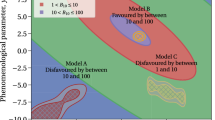
Overview
- Describes the QCD sum rules method in detail, including appendixes dealing with many technical points of the calculations involved
- Contains applications of MEM to QCDSR analyses to non-relativistic potential models, the ?-meson, the nucleon and quarkonium at zero and finite temperatures
- Nominated as an outstanding contribution by Tokyo Institute of Technology’s Physics Department in 2012
- Includes supplementary material: sn.pub/extras
Part of the book series: Springer Theses (Springer Theses)
Buy print copy
About this book
The author develops a novel analysis method for QCD sum rules (QCDSR) by applying the maximum entropy method (MEM) to arrive at an analysis with less artificial assumptions than previously held. This is a first-time accomplishment in the field.
In this thesis, a reformed MEM for QCDSR is formalized and is applied to the sum rules of several channels: the light-quark meson in the vector channel, the light-quark baryon channel with spin and isospin 1/2, and several quarkonium channels at both zero and finite temperatures.
This novel technique of combining QCDSR with MEM is applied to the study of quarkonium in hot matter, which is an important probe of the quark-gluon plasma currently being created in heavy-ion collision experiments at RHIC and LHC.
Similar content being viewed by others
Keywords
Table of contents (8 chapters)
-
Front Matter
-
Introduction and Review
-
Front Matter
-
-
Concluding Remarks
-
Front Matter
-
-
Back Matter
Authors and Affiliations
About the author
Tokyo Institute of Technology, Tokyo, Japan
Bibliographic Information
Book Title: A Bayesian Analysis of QCD Sum Rules
Authors: Philipp Gubler
Series Title: Springer Theses
DOI: https://doi.org/10.1007/978-4-431-54318-3
Publisher: Springer Tokyo
eBook Packages: Physics and Astronomy, Physics and Astronomy (R0)
Copyright Information: Springer Japan 2013
Hardcover ISBN: 978-4-431-54317-6Published: 20 April 2013
Softcover ISBN: 978-4-431-54696-2Published: 15 May 2015
eBook ISBN: 978-4-431-54318-3Published: 29 March 2013
Series ISSN: 2190-5053
Series E-ISSN: 2190-5061
Edition Number: 1
Number of Pages: XVI, 190
Topics: Quantum Field Theories, String Theory, Elementary Particles, Quantum Field Theory, Mathematical Physics



